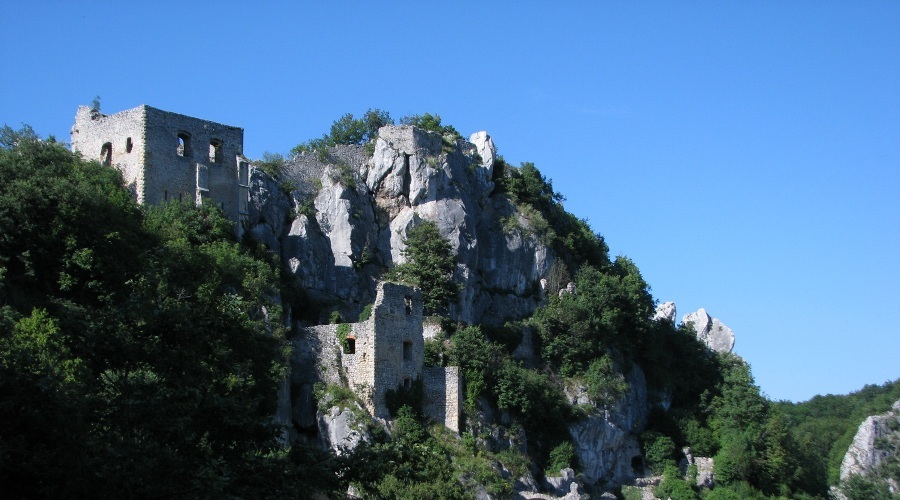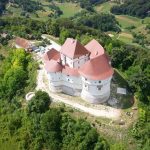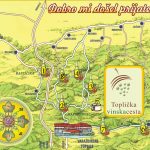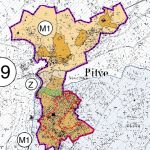Koprivnica Križevci County lies at the edge of the Panonian Basin, east of Zagreb, bordering Hungary on its North-Eastern side. The flat Panonian Plain on the North East, once a huge sea, gives way to rolling hills of Prigorje and is dominated by Mt Kalnik (2112′) on the Western side. Bilogora Mountain marks the county line with Bjelovar Bilogora County to the south East.
The fertile alluvial soil, the well drained slopes and the presence of a lot of calcium in the soil makes the area very suitable for grape growing and wine making. The wine making history in the region goes at least as far back as the Romans who wrote about it, and maybe as far back as the bronze and iron age Celtic and Illiryan tribes, who sadly had no written language.

Mt Kalnik (photo courtesy of Kalnik Tourist Board) is a major visitor attraction, with several ruined castles dating back to the dark ages, plus hiking, rock climbing and even paragliding. Plus of course many opportunities to sample the local delicacies and beverages! On the opposite end of the County is another remnant of the Pannonian Sea – the so called Croatian Sahara or Đurđevac Sands (Total Croatia News Article), also very popular with visitors.
The variety of soils, from the limestones of Kalnik, via the diluvial sediments of Koprivnica, to the sands of Đurđevac, gives a wide variety of tastes and wine types. Grapes that are represented in the region include graševina, pinot blanc, pinot gris, pinot noir, chardonnay, riesling, sylvaner, traminer, blaufrankisch, portugieser, zweigelt. There are also small but growing plantings of older indigenous varietals such as kraljevina, plemenka, lipovine, svetljak, beljak and kleščec.
The County has three towns (or cities as the Americans would call them), Koprivnica, Križevci and Đurđevac. The first time Križevci county was mentioned was in the year 1193. After the Turkish wars, Austrian Empress Maria Theresia restored the County seat to Križevci in 1759. The area was important to Austria as a buffer against the Turkish Empire and that was the time of rapid growth and much building. All three towns have well preserved old-Austrian style centers. The modern County was founded after Croatian independence in 1993.
There are three wine roads in the county. Koprivnica Wine Road, the Đurđevac Wine Road, and the Križevci-Kalnik-Orehovec Wine Road. Look for brown signs along the road.
The County has a County Tourist Board Web site.
The town of Križevci is known for its Wine Statutes (Križevački Štatuti). This is a set of semi serious drinking and party rules dating back to the thirteenth century, when open conflict between the Kalnik plum grower peasants ( Šljivari) and Križevci town dwellers was settled in a three day feast, and the rules of conduct drawn up for the first time. This avoided conflict at fairs and markets. An annual celebration, Križevačko Veliko Spravišče (roughly Big Križevci Party) is held in Križevci on the first weekend in June. The feast of St Martin (Martinje) on November 11th is another huge wine related celebration, when fermenting grape juice is officially turned into young wine. The other very significant wine feast is that of St Vincent or Vincekovo, on January 22nd, when dormant grapevines are festooned with all sorts of food to help them be productive in the coming season. Some even say the origins of Vincekovo go way back to pre-christian times when people were sacrificing precious food in the middle of winter to the gods of the grape. A unique Križevci institution is that of a wine “Bishop” who is elected according to the statutes, and who presides over the ceremonies, “blesses” the new wine, and generally regales the audience with tall tales and likely stories. For more see the Križevci Wikipedia article. For tourist info see the Križevci Tourist Board Web site.
Koprivnica, the County seat, is a little further North East, where the foothills of Kalnik meet the foothills of Bilogora. The name Koprivnica derives from ‘kopriva’ i.e. the nettle, and was first written down in 1207. During the Turkish wars, being closer to the border with Turkey, it became more important, with a big fortress, and military garrison. Today it is home to probably the best know Croatian food brand, Podravka, as well as a variety of light industry, and not forgetting the Croatian HW of Carlsberg Breweries. The nearby river Drava is a major visitor draw, as well as numerous lakes. Outdoor pursuits like hiking and hunting are popular. Nearby village of Hlebinje is the birthplace of Croatian naive art, and at the beginning of every July there is a Naive Art Festival. The other major festival is the Renaissance Fair amongst the remnants of the old earthworks at the end of August. Koprivnica Tourist Board Web site is here.
Đurđevac, the smallest and easternmost of the three towns, owes its position to the defensibility of a sandy hill, surrounded by the swamps of the river Drava. In the dark ages that was quite important. Later during the Turkish wars the town was attacked and besieged a number of times, but somehow survived. It is the only one of the three towns that has a complete castle. This now houses a museum. A popular fair is the Picokijada at the end of June. A ‘picok’ is local dialect for ‘rooster’. The legend goes back to the siege of Đurđevac by Ulama-beg. The starving defenders were left with one rooster, which they defiantly shot out of a cannon at the Turks. Seeing this, Ulama-beg believed the residents had plenty of food and lifted the siege, saying the residents, their children and their children’s children shall henceforth be known as ‘picoki’ or ‘roosters’. See the Đurđevac Tourist Bord Web Site.
Đurđevac is home to probably the biggest wine event held in the county, the Golden Wines of Alps Adriatic at the start of June. This annual international wine exhibition showcases wines from Austria, Hungary, Slovenia and various regions of Croatia. This year 54 producers submitted 59 varietal wines with 20 wines receiving scores above 85 highlighting the quality of the wines from the region. Many of the wine producers from the Koprivnica Križevci County took gold and silver medals.
The village of Kalnik also has an annual wine fair, held in the second week of June.
For full screen preview click here










